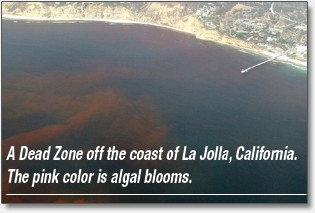2014 Gulf of Mexico "Dead Zone" is 5052 Square Miles

By Amy O'Donnell
An area of low oxygen or hypoxia, commonly known as the "dead zone," has appeared in the coastal waters of the Gulf of Mexico since 1972. The size of the dead zone varies from year to year. This year's dead zone, measured from July 27 to August 2, is roughly the size of Connecticut.
How 'Dead Zones' Form
The dead zone is caused in part by nutrients that are washed into the Gulf of Mexico from the Mississippi River. These nutrients may come from a variety of sources, including fertilizers from agriculture, golf courses, and suburban lawns, as well as discharge from sewage treatment plants. These excess nutrients cause algal blooms. As the algae die and decompose, oxygen is consumed, leading to low levels of oxygen in the water.
Seasonal stratification of the less dense, warmer freshwater over the denser, colder deep ocean water also contributes to hypoxic conditions in the Gulf. The layering prevents the oxygen-rich water on the surface from mixing with the oxygen-depleted deep water, allowing low oxygen levels to persist.
Impacts of Hypoxia
Sea life cannot survive the low-oxygen conditions in the dead zone. Adult fish, shrimp and other mobile animals survive by migrating to water with higher oxygen levels. However, less mobile animals like younger fish, mussels and crabs cannot escape hypoxic conditions and ultimately die. This loss of life reduces biodiversity and also diminishes the available food supply when oxygen levels rise and the larger fish and shrimp return. In addition to disrupting the ecosystem, the dead zone hurts the fishing and tourism industries in the Gulf.
Hypoxia does occur naturally in waters around the world. However, hypoxic conditions are occurring in shallow coastal waters more often as human nutrient inputs increase. There are as many as 550 dead zones throughout the world. The dead zone in the Gulf is the world's second largest.
Classroom Discussion
- What can be done to reduce nutrient runoff into waterways?